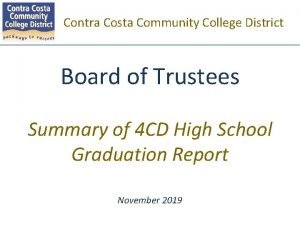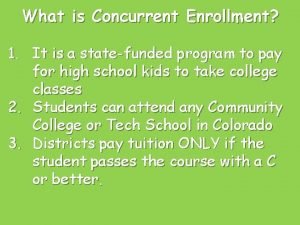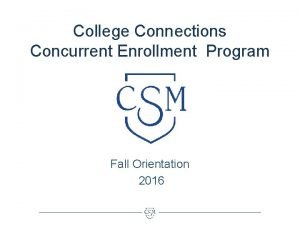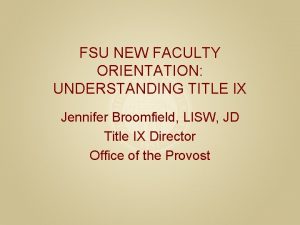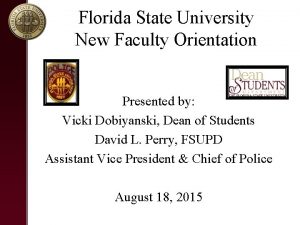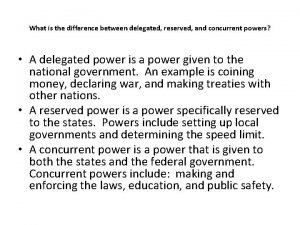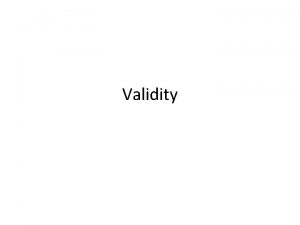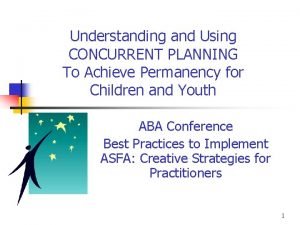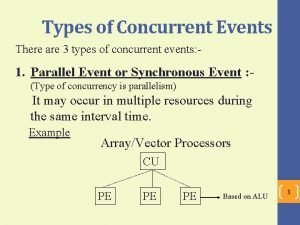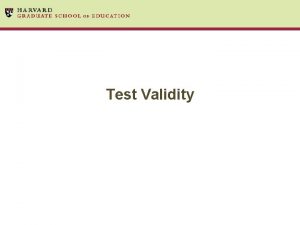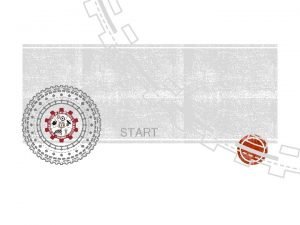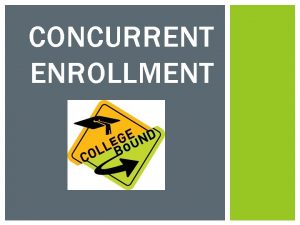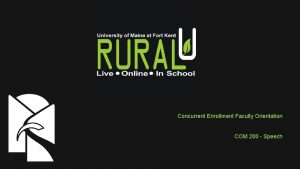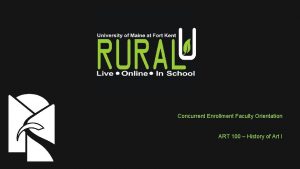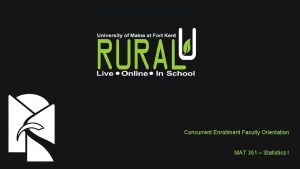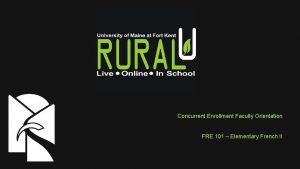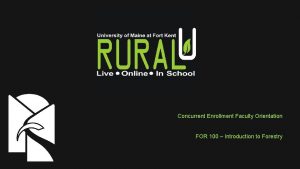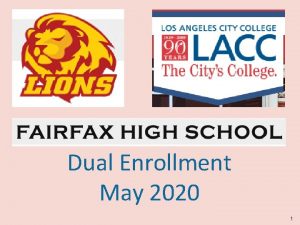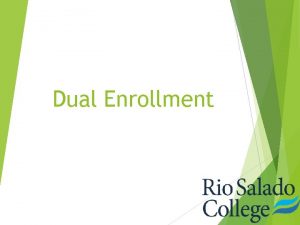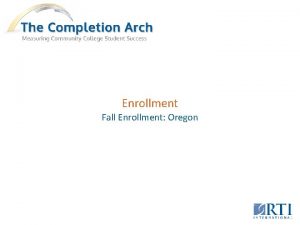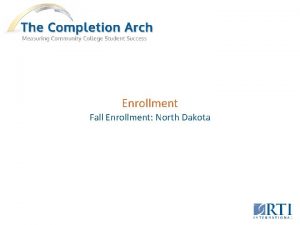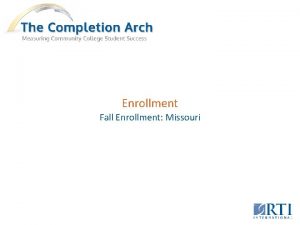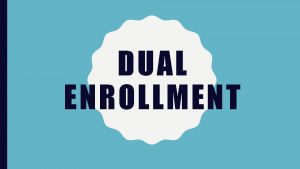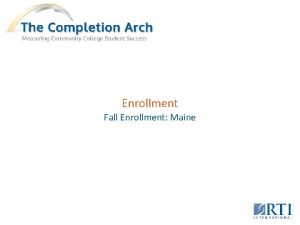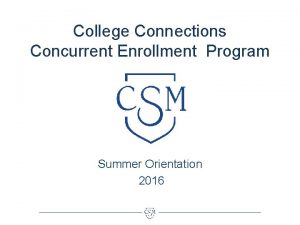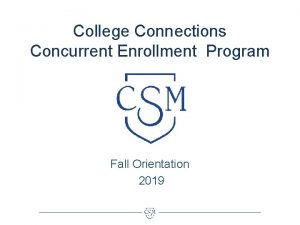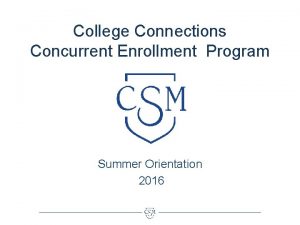Concurrent Enrollment Faculty Orientation Art 200 Fundamentals of























- Slides: 23

Concurrent Enrollment Faculty Orientation Art 200 – Fundamentals of Art

Welcome, and thank you for embarking on this adventure! This module is designed to give you, the instructor the tools needed to help you prepare to instruct classes in your selected field at your high school. This module goes over all details you need to know about teaching your course, such as a course description, course philosophy and objectives, and expected learning outcomes. Click here to visit our website

Concurrent Enrollment Faculty Expectations Faculty across all sections will be expected to follow the established: 1. Syllabus learning outcomes 2. Instructional objectives 3. Common/similar course assessments 4. All other essential elements Click here to visit our website

Remember! When you teach a Rural U Concurrent Enrollment course, you are not just preparing students for college – you are teaching a UMFK college course. You may do more than what is in the syllabus, but you may not do less! Click here to visit our website

Orientation Agenda Course Curriculum Course Description Course Philosophy Required Texts/Materials for Instructors Student Learning Outcomes Student Evaluation Grade Scale Sample Tests/Quizzes/Writing Prompts Administrative Responsibilities National Alliance of Concurrent Enrollment Partnerships New Course Orientation Site Visits Annual Discipline Specific Meeting Grade Submission Course Evaluations References Complete Evaluation Slide(s) Slide 6 Slide 7 Slide 8 Slides 9 -10 Slides 11 -12 Slide 13 Slides 14 -15 Slide 16 Slide 17 Slide 18 Slide 19 Slide 20 Slide 21 Slide 22 Slide 23

Course Description Prerequisites: None This is an introductory-level course in which students learn the elements and principles of two-dimensional design through hands-on studio practice. Class meetings include drawing with black and white media as well as color, and mixed media. Course includes lectures and discussions on related topics. Such topics may include non-Western art, aesthetics, and Western historical and modern art and artists. This course partially satisfies the University Core requirement in fine arts and is a prerequisite to all other studio art offerings 3 Credit Hours. Click here to visit our website

Course Philosophy Teaching methods include: Individualized instruction; hands on projects; demonstrations of techniques; visual lectures; field trips/gallery visits; and group and individual critiques. Click here to visit our website

Required Texts/Materials for Instructors None. There is no required text. Click here to visit our website

Student Learning Outcomes Students will be able to: 1. Utilize perceiving and visual thinking skills to produce representational and abstract artwork. 2. Produce a variety of two-dimensional artworks, including drawing, self portrait, negative space design and color drawing projects, using specific and/or combined media. 3. Understand how to utilize and apply media such as a variety of art pencils, charcoal and paint, as well as ways to mix media. 4. Create artwork applying elements of art, principles of design and color theory. Click here to visit our website

Student Learning Outcomes (continued) 5. Use the vocabulary of art to discuss, critique, compare and contrast their own work and work of others from a contemporary and historical perspective. 6. Increase their confidence as image makers. 7. Practice a creative and imaginative, open-ended mindset. 8. Identify works by a number of historically important artists. 9. Compare and contrast works of art as well as describe, analyze and interpret individual works. 10. Design and complete individual projects for a portfolio which will be displayed in a professional manner. Click here to visit our website

Student Evaluation METHOD OF EVALUATION OF STUDENT PERFORMANCE 1. Graded projects to be reviewed at mid-term and at the end of the course with individual and group critiques to be held during the class. Please see attached grading sheet. 2. In class assignments and homework assignments completed on time, will show evidence of attention to criteria provided, and a view to improvement over the course of the class. If in class studio work is submitted late it may be marked down one letter grade for each week it is late. If you are absent, it is your responsibility to make up the missed work. 3. Active participation in class discussions and group critiques using the vocabulary of art design, color and various art media is expected. 4. Mid term and final written quizzes taken. 5. Regular attendance. Click here to visit our website

Student Evaluation (continued) Evaluation Breakdown: 1. In-Class work(attendance, participation, in-class projects completed) 30% 2. Homework assignments – including journal/sketchbook 30% 3. Quizzes 20% 4. Class participation during critiques and facilitated discussion 20% Click here to visit our website

Grade Scale A AB+ B BC+ C CD+ D DF 94 -100 90 -93 87 -89 84 -86 80 -83 77 -79 74 -76 70 -73 67 -69 64 -66 60 -63 below 60 Click here to visit our website

Sample Tests/Quizzes/Writing Prompts Student Exemplars Click here to visit our website

Sample Tests/Quizzes/Writing Prompts (continued) Student Exemplars Click here to visit our website

National Alliance of Concurrent Enrollment Partnerships The University of Maine at Fort Kent’s Rural U program is working toward accreditation by the National Alliance of Concurrent Enrollment Partnerships (NACEP). NACEP works to ensure that college courses taught by high school teachers are as rigorous as courses offered on the sponsoring college campus. As the sole accrediting body for concurrent enrollment partnerships, NACEP helps these programs adhere to the highest standards so students experience a seamless transition to college and teachers benefit from meaningful, ongoing professional development. For more information, visit their website at: http: //www. nacep. org/

New Course Orientation Newly certified Rural U Concurrent Enrollment faculty are required to participate in the Rural U program orientation, which includes the course specific orientation, prior to teaching a new Rural U course. The purpose of this course orientation is to allow the faculty member to become familiar with the course prior to teaching. Rural U Concurrent Enrollment faculty will also have the opportunity to discuss the course with college faculty prior to teaching the course. Click here to visit our website

Site Visits 1. A faculty liaison from UMFK will conduct a site visit every 3 years. 2. During this visit, the faculty liaison may ask to see examples of exams, lab activities, and any other artifacts that will aid in determining if the course outcomes are being achieved. 3. An observation form will be shared with the Rural U Concurrent Enrollment faculty upon completion of the visit and may outline recommendations for improvements. 4. It is important to note, site visits are not an evaluation of you as a teacher. Site visits are conducted to determine if the course being taught is equivalent to the on-campus course. Click here to visit our website

Annual Discipline – Specific Meeting 1. Per NACEP standards – UMFK will host annual, discipline-specific professional development activities on campus and/or via distance technology. 2. These events are critical and required as they allow for open conversation between UMFK and Rural U Concurrent Enrollment faculty. 3. If UMFK identifies a pattern of absence over a two-year period, a Rural U administrator will discuss with the faculty member their continued participation in the program. Click here to visit our website

Grade Submission Rural U Concurrent Enrollment faculty must submit their final grades, in letter format, to Rural U program staff by February 1 (for fall classes) and June 30 (for spring classes). Classes that are a year-long must have grades submitted within the spring deadline. *In the event you are teaching a 4 -credit course with lab, please note you will need to enter two separate grades – one for the lecture part of the class and one for the lab part of the class. Click here to visit our website

Course Evaluations Rural U Concurrent Enrollment faculty must conduct end-of-term student university evaluations. These evaluations are comprised of questions focusing on the content of the course and are not an evaluation of your teaching methods. Results of the evaluation are available at your request, but these results do not have to be used in your personnel file. All evaluations will be provided to you by UMFK prior to the end of your class with instructions for completion. Click here to visit our website

References Rural U Homepage Click here to visit our website

New Course Orientation Survey To complete your New Course Orientation you will need to complete the brief survey found here https: //www. surveymonkey. com/r/88 HLK 8 F If you have been approved for more than one course, please review the other New Course Orientation presentations available before completing the survey. Should you have any questions or concerns please contact Rural U program staff. Click here to visit our website
 200+200+300
200+200+300 Contra costa college concurrent enrollment
Contra costa college concurrent enrollment Define concurrent enrollment
Define concurrent enrollment Uco academic advisement
Uco academic advisement Websmart smccd
Websmart smccd Fsu new faculty orientation
Fsu new faculty orientation Fsu dean of students case management
Fsu dean of students case management Greg naterer
Greg naterer Difference between ethnocentric and polycentric orientation
Difference between ethnocentric and polycentric orientation 200+200+100+100
200+200+100+100 600+800+800
600+800+800 300 + 300 + 200
300 + 300 + 200 200+200+100
200+200+100 100 + 100 200
100 + 100 200 200+200+300+300
200+200+300+300 Difference between delegated concurrent and reserved powers
Difference between delegated concurrent and reserved powers Discriminant validity
Discriminant validity Concurrent in os
Concurrent in os Concurrent planning definition
Concurrent planning definition Predictive validity
Predictive validity Concurrent events examples
Concurrent events examples Examples of concurrent validity
Examples of concurrent validity 500n
500n Non concurrent forces examples
Non concurrent forces examples

